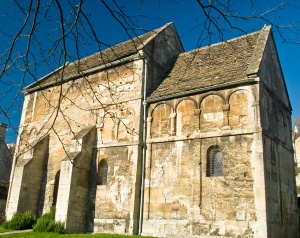
Think of tracking down Saxon and Danish remains as a detective story; a clue here, a suspicion there. Very few remains are readily found outside museums. This is partly due to the habit the Saxons had of building with impermanent materials (wood), and partly to the very nasty habits of the Viking raiders (they burned down everything in sight). Most of what remains is therefore from the post-Viking times of the 10th and 11th centuries. One exception is:
Churches
Many English churches have bits and pieces of earlier Saxon buildings contained within their walls. Literally within their walls. Saxon (and Roman) stones were used to build medieval churches. If you want to be a real historical detective, look for the rough-hewn Saxon stones amid the later work. They are most common around windows and door openings (look for round or triangular headed openings). Many churches also have Saxon foundations supporting a newer structure.
Where to look
You don't have to search quite so hard to get a good look at a complete Saxon church. Several fairly intact versions exist, notably Bradford-on-Avon (Wiltshire), Barton (Northamptonshire), Escomb (Durham), and Bradwell-on-Sea (Essex). Of these, Bradwell is the oldest, having been founded by St.Cedd in 654.

Saxon church plan
Church style
Churches during the early years of the Dark Ages were constructed in two different styles. In the south was the Roman model, as introduced by St.Augustine in Kent. This incorporated chambers to the sides of an aisle-less nave, and an apsidal chancel at the east end. In the north the Celtic monastic influence produced simple designs featuring tall naves with no side chambers, and rectangular chancels.
A special case is Greensted church (Essex). Founded about 845, it has been called "The oldest wooden church in the world." Set inside a modern brick exterior is a nave constructed of vertical oak logs, tongue-and-grooved in place without the use of nails. The original church had no windows, the only illumination being by torchlight.
Windows
Saxon church windows, mentioned above, were usually narrow, small, and deep set, with casings that splayed out to both the interior and the exterior. The heads were rounded or triangular in shape.
Church towers
One legacy of the Dark Ages can be seen from most places in England; church towers. No, all church towers are not Saxon, but the idea of towers was developed by the Saxons as a way of dealing with the threat of attack by the Danes. The towers could be used as lookout posts, and in times of attack they might be the only refuge for villagers from the invaders. The idea took hold from physical necessity, then became a tradition in church architecture.
Crosses
When Christianity in England was young there were no parish or village churches. Instead, carved crosses were erected at convenient sites for itinerant monks or priests to preach to the inhabitants. These crosses may have been put up at sites which were already regarded as sacred in pagan worship. Later on, churches were built at the same spots, preserving a continuity of worship. Some of the finest crosses still to be seen are at Ilkley (West Yorkshire), Gosforth and Irton (both in Cumbria), and Bakewell (Derbyshire).
Related articles:
The English parish church
Anglo-Saxon architecture
Anglo-Saxon Towns
Also see Anglo-Saxon London in our London History section.

